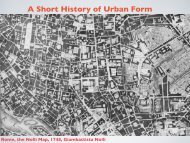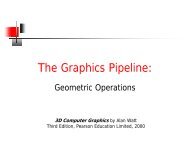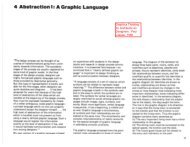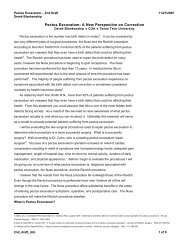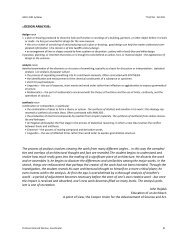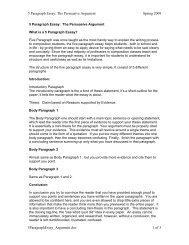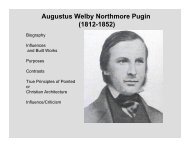The Eyes of the Skin
The Eyes of the Skin
The Eyes of the Skin
Create successful ePaper yourself
Turn your PDF publications into a flip-book with our unique Google optimized e-Paper software.
<strong>The</strong> Body in <strong>the</strong> CentreI confront <strong>the</strong> city with my body; my legs measure <strong>the</strong> length <strong>of</strong> <strong>the</strong> arcadeand <strong>the</strong> width <strong>of</strong> <strong>the</strong> square; my gaze unconsciously projects my bodyonto <strong>the</strong> facade <strong>of</strong> <strong>the</strong> ca<strong>the</strong>dral, where it roams over <strong>the</strong> mouldings andcontours,sensing <strong>the</strong> size <strong>of</strong> recesses and projections; my body weightmeets <strong>the</strong> mass <strong>of</strong> <strong>the</strong> ca<strong>the</strong>draldOOl~and my hand grasps <strong>the</strong> door pullas I enter <strong>the</strong> dark void behind. I experience myself in <strong>the</strong> city,and <strong>the</strong> cityexists through my embodied experience. <strong>The</strong> city and my body supplementand define each o<strong>the</strong>r. I dwell in <strong>the</strong> city and <strong>the</strong> city dwells in me.Merleau-Ponty'sphilosophy makes <strong>the</strong> human body <strong>the</strong> centre <strong>of</strong> <strong>the</strong>experiential world. He consistently argued, as Richard Kearney summarises,that' [i]t is through our bodies as living centres <strong>of</strong> intentionality... that we choose our world and that our world chooses us,.75 InMerleau-Ponty'sown words, 'Our own body is in <strong>the</strong> world as <strong>the</strong> heartis in <strong>the</strong> organism: it keeps <strong>the</strong> visible spectacle constantly alive, itbrea<strong>the</strong>s life into it and sustains it inwardly, and with it forms a system,/6and '[s]ensory experience is unstable and alien to natural perception,which we achieve with our whole body all at once, and which opens ona world <strong>of</strong> interacting senses'. 77Sensory experiences become integratedthrough <strong>the</strong> body, or ra<strong>the</strong>l~ in<strong>the</strong> very constitution <strong>of</strong> <strong>the</strong> body and <strong>the</strong> human mode <strong>of</strong> being.Psychoanalytic <strong>the</strong>ory has introduced <strong>the</strong> notion <strong>of</strong> body image or bodyschema as <strong>the</strong> centre <strong>of</strong> integration. Our bodies and movements are inconstant interaction with <strong>the</strong> environment; <strong>the</strong> world and <strong>the</strong> self informand redefine each o<strong>the</strong>r constantly. <strong>The</strong> percept <strong>of</strong> <strong>the</strong> body and <strong>the</strong>image <strong>of</strong> <strong>the</strong> world turn into one single continuousexistential experience;<strong>the</strong>re is no body separate from its domicile in space, and <strong>the</strong>re is nospace unrelatedto <strong>the</strong> unconscious image <strong>of</strong> <strong>the</strong> perceiving self.'<strong>The</strong> body image ... is informed fundamentallyfrom haptic and orientingexperiences early in life. Our visual images are developed later on,and depend for <strong>the</strong>ir meaning on primal experiences that were acquiredhaptically,' Kent C Bloomer and Charles W Moore argue in <strong>the</strong>ir bookBody, I'demory, and Architecture, one <strong>of</strong> <strong>the</strong> first studies to survey <strong>the</strong>role <strong>of</strong> <strong>the</strong> body and <strong>of</strong> <strong>the</strong> senses in architectural experience.78 <strong>The</strong>y goon to explain: 'vVhat is missing from our dwellings today are <strong>the</strong> potentialtransactions between body, imagination, and environment,/9 ... 'Toat least some extent every place can be remembered,partly because it isunique, but partly because it has affected our bodies and generatedenough associations to hold it in our personal worlds.,8oMulti-SensoryExperienceA walk through a forest is invigorating and healing due to <strong>the</strong> constantinteraction <strong>of</strong> all sense modalities; Bachelard speaks <strong>of</strong> '<strong>the</strong> polyphony <strong>of</strong><strong>the</strong> senses,.81 <strong>The</strong> eye collaborateswith <strong>the</strong> body and <strong>the</strong> o<strong>the</strong>r senses.One's sense <strong>of</strong> reality is streng<strong>the</strong>ned and articulated by this constantinteraction. Architecture is essentially an extension <strong>of</strong> nature into <strong>the</strong>man-made realm, providing <strong>the</strong> ground for perception and <strong>the</strong> horizon<strong>of</strong> experiencing and understanding <strong>the</strong> world. It is not an isolated andself-sufficient artifact; it directs our attention and existential experience towider horizons. Architecture also gives a conceptual and material structureto societal institutions, as well as to <strong>the</strong> conditions <strong>of</strong> daily life. Itconcretises <strong>the</strong> cycle <strong>of</strong> <strong>the</strong> year, <strong>the</strong> course <strong>of</strong> <strong>the</strong> sun and <strong>the</strong> passing <strong>of</strong><strong>the</strong> hours <strong>of</strong> <strong>the</strong> day.Every touching experience <strong>of</strong> architecturespace, matter and scale are measuredis multi-sensory; qualities <strong>of</strong>equally by <strong>the</strong> eye, ear, nose, skin,tongue, skeleton and muscle. Architecture streng<strong>the</strong>ns <strong>the</strong> existentialexperience,one's sense <strong>of</strong> being in <strong>the</strong> world, and this is essentially astreng<strong>the</strong>ned experience <strong>of</strong> self. Instead <strong>of</strong> mere vision, or <strong>the</strong> five classicalsenses, architecture involves several realms <strong>of</strong> sensory experiencewhich interact and fuse into each o<strong>the</strong>r.82<strong>The</strong> psychologist James J Gibson regards <strong>the</strong> senses as aggressivelyseeking mechanisms ra<strong>the</strong>r than mere passive receivers. Instead <strong>of</strong> <strong>the</strong> fivedetached senses, Gibson categorises <strong>the</strong> senses in five sensory systems:visual system, auditory system, <strong>the</strong> taste-smell system, <strong>the</strong> basic-orienting40THE EYES OFTHE SKINPART 2 41




